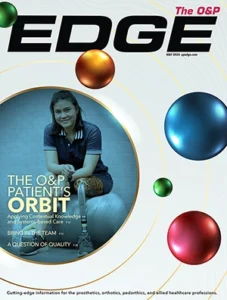Original Post at the end WITH REPLIES (Part 1):
As always, a wide range of opinions and great responses…
At our hospital we DO use a rigid removable postoperative dressing and post-surgical socks. We have always advised NOT to don shrinkers until the patient’s pain level and wound site healing can tolerate it (varies). As an easy to remember “protocol,” we recommend shrinkers to the doctors when the sutures are removed (since each surgery team varies widely on when they remove their sutures). There are many rehabilitation teams that work around us who are much more aggressive with shrinkers, so sometimes we do provide them ahead of our “recommended” schedule. We have not historically provided any donning aid (because according to our schedule of use they would not need one).
Stephanie Romero (original poster)
In my opinion the first step in volume control after surgery should be a custom fitted splint fitted over post-surgical dressing and post-surgical socks. Shrinkers should never be applied until the wound site is stable and well healed. Donning shrinkers can be facilitated by applying a sheath first and sewing loops approximately 6″ long to both sides of the shrinker.
We have faced a ton of confusion with regard to post amputation management through the years. Just so you know, we have a tried and true system to help some.
We have developed and use both a post-operative amputation protector and a new design of donning tube. We call them AtlanticPROtector and SockPRO. These are new- and patented- products that we are beginning to market.
In our practice, have found patients are more independent with the SockPRO then with a piece of “schedule 40 sewage pipe”. SockPRO is designed with handles and a slot to allow patients who have flexibility limitations to function independently with donning compression socks/shrinkers without discomfort or irritation to the new incision line. We provide both written instructions and a link to a YouTube video.
The post-operative protector, called the AtlanticPROtector, is designed to be soft and universal. It’s been a real game-changer in my practice.
Hope this helps address your issues. We do use them. We don’t charge patients for the SockPRO if they are going to be working with us, whether it’s provided in conjunction with the AtlanticPROtector or not.
Please feel free to contact me if I can help.
JP Donovan, CPO
Owner/CEO
AtlanticProCare
1274 Congress St
Portland, ME 04102
207.774.1002
atlanticprocare.com
The Dawner is a great device
I bill our local hospital for donning aid. Knit rite makes a nice clear tube in 6″ and 8″ that is a life saver for donning shrinkers 1-30 days post op. We charge about $60 for them. They are not cheap to buy, but not really into handing out coffee cans in the hospital.
I use PVC pipe. Cut to length and smooth the edges.
I routinely use donning aids, especially new amputees under 10 days post op. It helps tremendously with the pain of donning the shrinker and achieves much better distal contact. We buy Rubbermaid pitchers for $3 each and cut the top and bottom off to form a large plastic tube. Works great, rehab staff loves them.
Giving stuff away to patients could be considered an inducement. Donning aids should be provided by the rehab.
We provide the knit-right clear colored donning tube aids free of charge to all our hospital fittings. They cost around $45 and we consider it a small price to pay and have found it to be a very useful marketing tool to the hospital considering that hospital fittings represent a significant percentage of our new patient referrals.
We have also noticed many situations of personal thanks from the staff and patients who also work with company X who does not provide these.
I give them away. I have found that if you go to a plumbing supply and get large (usually green) 8″ pvc pipe and cut it into segments and set aside. I cut 10″ segments and tycro smooth edges. Clean with degreaser and put company logo on it. I have techs cut them once a month and have a little inventory. Cheap and can even add handles if you want to be fancy. Good luck.
Go to your local paint store and buy new clean metal paint cans. Cut the metal carry handle off with snips and you’re done. These look nice and clean and shiny, don’t smell like coffee and have a smooth outside. I have my company info on a sticker on the outside of the can. Can’t hurt to have my name out there can it? I always provide instructions to hospital staff and the patient. There is no cost for these that I charge. Works for most TTs. Beyond that, a large section of pipe for really large limbs would have to do.
I would go to Lowe’s and purchase a 2 foot section of thick PVC pipe. Cut it in three sections and smooth the edges. The thicker PVC worked better. I would also put a sticker with illustrations for the nurses and therapists. I made them available for hospital use and for my patients. The patients of my competitors would try to take them home. Sure beats screaming patients.
We have given PTs and nursing at a rehab hospital the donning tubes so they can use it on the patients. We don’t give them to the pt but the patients sometimes steal it from the hospital and then we have to replace them but cuts down on cost. We also explain to the PTs and nurses that is only needed in acute care b/c after the second week, they won’t need it. That’s how we have dealt with it. Hope this helps.
We use 6″ or 8″ sewer pipe (green plastic) cut to 8″ lengths…,works great and work out to about $5 per patient so no worries about not charging. The PT dept loves it
We do not normally provide any donning aids. Honestly, hardly anybody needs one imo. Most people can figure out a technique that works for them on their own after a bit of trial and error. They are then not reliant on the aid and can put their shrinker on anywhere. In the very rare occurrence when one is needed we usually will make them one for free. I think in 10 years this has happened 2x.
My daughter is an OT and they like to be in on this. PVA pipe with cord is good and no there is no codes for it. Put your name address phone on it and give out like candy at inservice etc
The easiest thing to do is use a short piece of PVC pipe larger in diameter than the patient. No I would not charge for it.
Original POST:
For those who are providing shrinkers to patients postoperatively in the hospital, or to new amputees before their first prosthesis:
Are you providing donning aids? Are you saving coffee cans and giving them out? What are your solutions to those who need donning aid?
If you do provide a donning aid, is it free (with shrinker)? Do you charge? How much? Do you use a code?
I was curious because a local inpatient rehabilitation facility complained to us, stating “Unnamed Company X always provides donning aids for their patients.”
I was curious to see if it was standard for the industry to provide donning aids or if there are other ways you have approached it.
I am aware of a few things (like the classic large coffee can, having two people help put it on), but I really want to know what facilities are PROVIDING TO PATIENTS with the shrinker, in addition to “tips” on how to don them.
Doesn’t matter BK or AK, although we do more BK than AK.
Stephanie Romero, CO, MSPO
Certified Orthotist/Prosthetic Resident
Carrie Tingley Hospital/University of New Mexico Hospital
Phone: 505-272-5335
Fax: 505-272-4232




